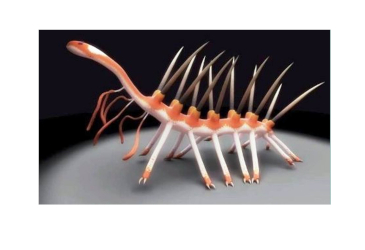Psalm 113:3
“From the rising of the sun unto the going down of the same the LORD’S name is to be praised.”
 When a very bizarre animal was first discovered in the Burgess shale of the Canadian Rocky Mountains, scientists literally couldn’t tell its head from its tail. In fact, when they reconstructed the worm-like creature, they got it totally wrong. They assembled it upside down and put its head where its tail should be.
When a very bizarre animal was first discovered in the Burgess shale of the Canadian Rocky Mountains, scientists literally couldn’t tell its head from its tail. In fact, when they reconstructed the worm-like creature, they got it totally wrong. They assembled it upside down and put its head where its tail should be.
Even after finally getting it all sorted out, the creature still looks like something you’d see in a hallucination or a nightmare. That’s why they called it Hallucigenia. This odd-looking animal was a little over two inches long and had seven pairs of nail-like spines sticking out from its back. On its underside were an equal number of flimsy legs, tipped with claws. And it had a single row of tentacles hanging down from its neck.
Using sophisticated imaging technology, scientists learned that the head was actually at the end of a long, tube-like neck. Near the end of the head were two bean-shaped eyes. “Below the eyes, like an almighty grin, sits a ring of teeth,” University of Cambridge paleontologist Martin Smith said.
With all these various body parts, this is pretty complex for an animal without an ancestor, wouldn’t you say? Yes, the Burgess shale and the Cambrian explosion have always been a nightmare for evolutionists. After all, how can such a wide variety of highly complex creatures suddenly pop into existence out of nowhere? If they evolved, what did they evolve from? What a nightmare for evolutionists!
Prayer: Heavenly Father, though You filled our world with many bizarre creatures, I thank You for each one of them because they serve as a testimony to Your great creative genius! Amen.
Author: Steven J. Schwartz
Ref: “Hallucination? No, this Cambrian period creature was really weird,” Digital Journal | Science, 6/24/15. Photo: Artist’s representation of what Hallucigenia really looked like. (CC-Attribution-NoDerivs)
© 2015 Creation Moments. All rights reserved.
